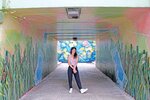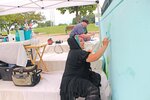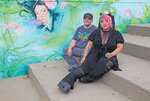By Talia McWright
Kao Lee Thao and Ash Kubesh spent 66 hours over 10 days painting two new murals that represent Thao’s Hmong heritage at Boom Island Park. The artwork is part of the Minneapolis Parks and Recreation Board’s 2023 “Parks for All Mural Project.”
Nine artists in all were chosen to paint murals at multiple park locations, with the aim to decrease tagging and vandalism.
Parks for All is a comprehensive plan adopted by the board in 2021 as a way to create and accomplish nine goals that will sustainably benefit parks across the state for years to come. (See sidebar for complete list.) The mural project was funded through the board’s budget and grant initiatives, as well as by local organizations. Artists were chosen for the mural project through a call for artists application in collaboration with Forecast Public Art. Over 140 artists applied. Once selected, the artists were given $6,000 for labor and $3,000 for materials.
“I’m really excited to help communicate out to community what the park board has adopted as policy through the interpretation of visual artists,” Carrie Christensen said.
Christensen, a Saint Paul resident, is a senior planner for Minneapolis Parks and Recreation Board with a background in urban planning, landscape architecture, strategic planning and more. Her role with Minneapolis Parks and Rec has allowed her to use her previous experience in her current position. Christensen leads the comprehensive planning process for the Parks for All initiative. The project is a collaboration between the Minneapolis Parks and Recreation planning division that works with policy, and the paint shop that focuses on park maintenance.
“This is a really fun partnership for us where we both identify that there is a need in our system for maintaining clean and well-managed park infrastructure,” Christensen said.
Artists were chosen, in part, based on their prior experience creating murals. They were paired with parks based on their connectedness to the goals and their familiarity with the park. The nine goals for the Parks for All project are to be in effect for the next 15 years. Christensen explained that it’s important for the park board to support artists that are a part of or have close connections to the communities by funding their work.
“I have a deep belief in the power of arts and artist storytelling in helping engage community in civic space making,” Christensen said.
Once painted, the board’s paint shop is responsible for mural upkeep. As tagging and vandalism are a concern, the paint shop takes measures to preserve the artwork by painting protective coatings on the murals that make it easier to wash away damage, touch up paint chipping, and clean as needed.
“Basically the artists install the murals, and we’ll take it from there and care for the murals,” Christensen said.
Artist Jacqui Rosenbush
Artist Jacqui Rosenbush, a Bloomington resident, is the chair of the city’s Creative Place Making Commission. Rosenbush is a painter and has worked on over 35 murals, many of which she created during her time working with GoodSpace Murals. She also works with the non-profit performing arts circus school for youth, Circus Juventas, creating artistic pieces for their productions.
“I really love design on an epic scale and how we experience spaces, so that drives a lot of the kinds of work that I do and murals are a part of that scope,” Rosenbush said.
Rosenbush has a bachelor’s degree in studio art from the University of Minnesota. She has a background in sculptural art, and is captivated by the immersive experience of sculptural art. She spent nine years working with Greta McLain and GoodSpace Murals, and has been an independent artist for two years.
“Its been a lifelong pursuit and I’m sure it’ll keep going for my whole life,” Rosenbush said.
For the Parks for All Mural Project, Rosenbush was assigned goal number four – “Work from our strengths and determine our role in partnerships” – at the Lake Harriet trolley tunnel. Rosenbush’s project specifically highlighted the management of water quality. She expressed that this goal encompassed the role of the relationship between people and nature in managing water quality. During design preparation, she researched water quality control, and included lily pads and cattails in her mural after discovering the large role they play in filtering water.
“I wanted to look at those two things, water quality and relationship through the lens of leveraging a natural relationship that we can use to foster better care of the water,” Rosenbush said.
Her favorite artist is sculptor Andy Goldworthy because he creates temporary art with materials found in nature. In her work with Circus Juventas, Rosenbush gets to practice this style of temporary art, as her work is used during a season of performances, then removed. Nature is a large aspect of the artist’s work, which influences her impressionistic and expressionistic painting style. She enjoys painting murals because of how large the work is and its attachment to the location.
“I really enjoy tunnels because they’re such transitional spaces, and they’re usually a space that’s a bit dark so I love to come in and bring a brightness to it,” Rosenbush said. “My favorite part of the design process is thinking about how someone will experience the whole thing.”
Rosenbush has worked on many community-oriented projects in the past. She explained that she enjoys working on projects that involve community members, and allow people to experience art in a personal way. Her work is connected to her spiritual life and belief in God, and she is excited to partake in something larger than herself.
“Its [art] become the most true thing that I’ve done in my life,” Rosenbush said. “It’s so connected to who I am that it’s just an outpouring of me. It feels very authentic and alive and exciting to really harness the power of being an artist.”
Artists Kao Lee Thao and Ash Kubesh
Thao and Kubesh have worked together since 2003. The two started a 3D animation studio, Folklore Studio, in 2004. Together they have worked on over eight murals. Kubesh is a technical artist with a background in ceramics. He combines both ceramics and technology in his work with Folklore Studio. Thao works often with watercolor art which she describes as loose and fluid. Over the many years of working together, the two said that they have each learned different sets of skills from one another. They agreed that they both support their individual and collective artistic goals, and that working as a team has made it easier to keep going.
Thao was assigned goal number seven – connect through communication and technology – on the Boom Island river wall. As an animator, Thao felt excited to work on this goal as it combined her passion for fine arts and technology. After finishing the mural, she plans to add augmented reality (AR) components to the piece, making the painting an interactive experience.
“I try to connect community with technology because AR is the future right now,” Thao said.
Much of her inspiration for the mural comes from her Hmong heritage. She explained that in Hmong culture, water holds significance as many believe that dragons may lurk in open bodies of water. To change the fearful narrative, Thao painted a dragon that is meant to be playful and inviting. She also expressed that the mural symbolized a journey for many Hmong people who had to cross the Mekong river due to the Vietnam war, and those who came to America and changed their views and beliefs since living in the country. Her intent with the mural was both to represent and validate these experiences.
“It’s a reminder that nature is so important,” Thao said. “I think we forget about that because we’re so attached to our technology and social media, but being out in nature is really important.”
The mural is painted with bright colors of teal and green, pink and orange. For Thao, the colors aren’t only vibrant because they’re her favorite colors, but because they represent the diversity of the communities she lives and works in.
“I paint with vibrant colors because it speaks to people of color,” Thao said.
Thao also painted a woman on one side of the mural wall. She described how in Hmong culture, women often hand stitch their clothing and costumes. The woman Thao painted in bright colors on the mural, is inspired by and in honor of Hmong women.
“Over there she symbolizes mother nature and earth,” Thao said looking at the woman she painted on the mural. “When you see a woman in my pieces, it’s like she’s a storyteller. Like she’s telling a story about the importance of water and parks and nature.”
The Parks for All Mural Project is set to be completed in the fall. Minneapolis Parks and Recreation Board plans to have an unveiling celebration once all the murals are finished, which they will announce on their website



Comments
No comments on this item Please log in to comment by clicking here